Related Research Articles
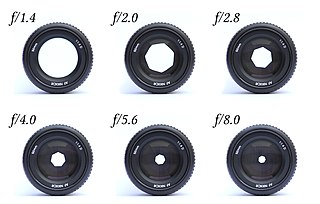
In optics, an aperture is a hole or an opening through which light travels. More specifically, the aperture and focal length of an optical system determine the cone angle of the bundle of rays that come to a focus in the image plane.
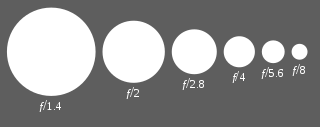
An f-number is a measure of the light-gathering ability of any optical system like a camera lens or even the human eye. It is calculated by dividing the system's focal length by the diameter of the entrance pupil. The f-number is also known as the focal ratio, f-ratio, or f-stop, and it is key in determining the depth of field, rate of light scattering, and exposure of a photograph. The f-number is dimensionless that is usually expressed using a lower-case hooked f with the format f/N, where N is the f-number.

Subaru Telescope is the 8.2-metre (320 in) telescope of the National Astronomical Observatory of Japan, located at the Mauna Kea Observatory on Hawaii. It is named after the open star cluster known in English as the Pleiades. It had the largest monolithic primary mirror in the world from its commissioning until 2005.

An optical telescope is a telescope that gathers and focuses light mainly from the visible part of the electromagnetic spectrum, to create a magnified image for direct visual inspection, to make a photograph, or to collect data through electronic image sensors.
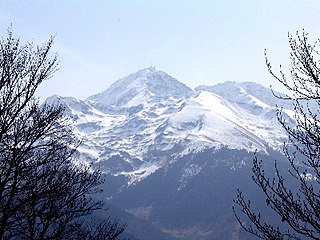
The Pic du Midi de Bigorre or simply the Pic du Midi is a mountain in the French Pyrenees. It is the site of the Pic du Midi Observatory.
Bernard Ferdinand Lyot was a French astronomer.

A coronagraph is a telescopic attachment designed to block out the direct light from a star or other bright object so that nearby objects – which otherwise would be hidden in the object's bright glare – can be resolved. Most coronagraphs are intended to view the corona of the Sun, but a new class of conceptually similar instruments are being used to find extrasolar planets and circumstellar disks around nearby stars as well as host galaxies in quasars and other similar objects with active galactic nuclei (AGN).

Delta Andromedae, Latinized from δ Andromedae, is a triple star system in the northern constellation of Andromeda. The system is visible to the naked eye as a point of light with a combined apparent visual magnitude of 3.28. Based upon parallax measurements, it is located at a distance of approximately 105.5 light-years from the Sun. The system is drifting closer with a radial velocity of −10 km/s.
A Lyot filter, named for its inventor Bernard Lyot, is a type of optical filter that uses birefringence to produce a narrow passband of transmitted wavelengths. Lyot filters are often used in astronomy, particularly for solar astronomy.
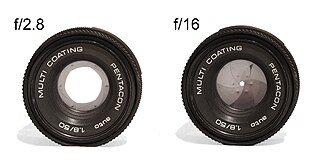
In an optical system, the entrance pupil is the optical image of the physical aperture stop, as 'seen' through the front of the lens system. The corresponding image of the aperture as seen through the back of the lens system is called the exit pupil. If there is no lens in front of the aperture, the entrance pupil's location and size are identical to those of the aperture. Optical elements in front of the aperture will produce a magnified or diminished image that is displaced from the location of the physical aperture. The entrance pupil is usually a virtual image: it lies behind the first optical surface of the system.

In optics, a ray is an idealized geometrical model of light or other electromagnetic radiation, obtained by choosing a curve that is perpendicular to the wavefronts of the actual light, and that points in the direction of energy flow. Rays are used to model the propagation of light through an optical system, by dividing the real light field up into discrete rays that can be computationally propagated through the system by the techniques of ray tracing. This allows even very complex optical systems to be analyzed mathematically or simulated by computer. Ray tracing uses approximate solutions to Maxwell's equations that are valid as long as the light waves propagate through and around objects whose dimensions are much greater than the light's wavelength. Ray optics or geometrical optics does not describe phenomena such as diffraction, which require wave optics theory. Some wave phenomena such as interference can be modeled in limited circumstances by adding phase to the ray model.

NGC 6193 is open cluster containing 27 stars in the constellation Ara, visible to the unaided eye. NGC 6193 lies at the center of the Ara OB1 association, which extends over a square degree. The cluster is associated with neighboring regions of the nebulosity NGC 6188.

Lyot is a large peak ring crater in the Vastitas Borealis region of Mars, located at 50.8° north latitude and 330.7° west longitude within the Ismenius Lacus quadrangle. It is 236 km in diameter. Its name refers to Bernard Lyot, a French astronomer (1897–1952).
The Large Angle and Spectrometric Coronagraph (LASCO) on board the Solar and Heliospheric Observatory satellite (SOHO) consists of three solar coronagraphs with nested fields of view:

Proba-3 is a technological demonstration mission by the European Space Agency devoted to high precision formation flying to achieve scientific coronagraphy. It is part of the series of PROBA satellites that are being used to validate new spacecraft technologies and concepts while also carrying scientific instruments.

HD 92945 is a K-type main sequence star in the constellation of Hydra. Its apparent visual magnitude varies by 0.02 magnitudes and is approximately 7.72 at maximum brightness.
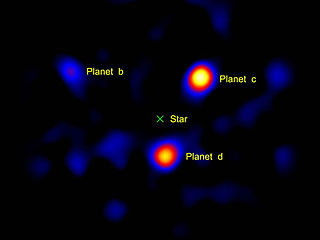
A vortex coronagraph is a type of optical instrument for telescopes that blocks out the glare of bright objects so that smaller objects near them can be seen. For example, extrasolar planets near their host star as seen from Earth or space telescopes in Earth's solar system. It is a type of coronagraph.
Project 1640 is a high contrast imaging project at Palomar Observatory. It seeks to image brown dwarfs and Jupiter-sized planets around nearby stars. Rebecca Oppenheimer, associate curator and chair of the Astrophysics Department at the American Museum of Natural History, is the principal investigator for the project.
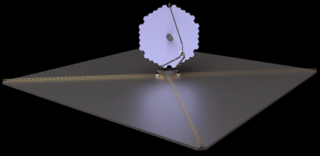
The Large Ultraviolet Optical Infrared Surveyor, commonly known as LUVOIR, is a multi-wavelength space telescope concept being developed by NASA under the leadership of a Science and Technology Definition Team. It is one of four large astrophysics space mission concepts studied in preparation for the National Academy of Sciences 2020 Astronomy and Astrophysics Decadal Survey.
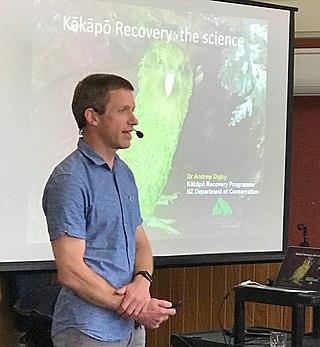
Andrew Digby is an astronomer and ecologist whose work focusses on researching and conserving New Zealand's endangered endemic birds.
References
- ↑ Lyot, Bernard (1939). "The Study of the Solar Corona and Prominences without Eclipses (George Darwin Lecture, delivered by M. Bernard Lyot, Assoc.R.A.S., on 1939 May 12)". Monthly Notices of the Royal Astronomical Society . 99 (8): 580–594. Bibcode:1939MNRAS..99..580L. doi: 10.1093/mnras/99.8.580 .
- ↑ "The near-infrared camera SWIRCAM". Archived from the original on 4 March 2016. Retrieved 25 December 2012.